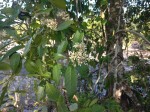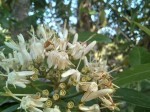| Home | > | List of families | > | Rubiaceae | > | Tarenna | > | pavettoides |
Tarenna pavettoides
gillmanii
Selected images: Click on each image to see a larger version and details of the record View all images (4)
Habit
Riverine forest fringe
Zambezi Rapids, c. 5 km N of Kalene Hill, Ikelenge District
Oct 2024
Photo: Nick Wightman
Inflorescence
Riverine forest fringe
Zambezi Rapids, c. 5 km N of Kalene Hill, Ikelenge District
Oct 2024
Photo: Nick Wightman
Inflorescence
Riverine forest fringe
Zambezi Rapids, c. 5 km N of Kalene Hill, Ikelenge District
Oct 2024
Photo: Nick Wightman
Flowers
Riverine forest fringe
Zambezi Rapids, c. 5 km N of Kalene Hill, Ikelenge District
Oct 2024
Photo: Nick Wightman
Detailed records: Display species records QDS maps by: Google Maps Point records by Google Maps
Species details: Click on each item to see an explanation of that item (Note: opens a new window)
| Synonyms: | |
| Common names: | |
| Frequency: | |
| Status: | |
| Description: |
Small tree or shrub, 2.75–10 m tall; young branches glabrous or with appressed hairs, older stems square, covered with buff to red-brown sometimes flaking bark. Leaf blades often anisophyllous, drying black or greenish to brown, 5–20 × 2–8.8 cm, oblanceolate to obovate or sometimes broadly elliptic, acuminate or sometimes acute at apex, cuneate at base, sometimes with margins undulate, chartaceous to subcoriaceous or papery, shiny above, glabrous above or sometimes becoming pubescent towards base of midrib, glabrous to glabrescent with the nerves glabrous or glabrescent to pubescent beneath; domatia present; petiole 0.5–3 cm long, glabrous or with appressed hairs; stipule limbs with a blackened area when dry, deltoid, 2–6 mm long, gradually narrowed or with a subulate acumen 1–6 mm long, glabrous or less often with appressed hairs outside, eventually deciduous. Inflorescences terminal on main and moderately short lateral branches, moderately lax to congested, sessile, usually with 1–3 pairs of pedunculate inflorescences arising from the next 1–2 nodes down, frequently with the supporting leaves reduced or absent, rarely with only the axillary branches present; primary inflorescence branches 0.6–2 cm long, covered with greyish to ± golden appressed hairs; pedicels 0–8 mm long, densely covered with appressed hairs; bracteoles inconspicuous, subulate to filiform. Calyx sparsely to densely pubescent; tube 1–1.5 mm long; limb 1–2.25 mm long, wider than tube, divided for ± half its length into ovate to deltoid or oblong apiculate lobes. Corolla white; tube 3–6.5 mm long, glabrous outside, pubescent at throat; lobes 3.5–6 × 1.5–2.5 mm, oblong, rounded, sometimes apiculate or tending to be emarginate. Fruit glaucous green or white (or ?pale blue) turning black when dry, 4–8 mm in diameter, containing 2–15 seeds; calyx limb persistent. Seeds brown, shiny, 2.5–4 mm across, smooth. Subsp. gillmanii differs from the other subspecies in the leaf blades thinly coriaceous, drying greenish to dark brown; young stems densely covered with appressed hairs or occasionally glabrous. |
| Type location: |
Tanzania |
| Notes: | |
| Derivation of specific name: | pavettoides: Pavetta-like, another genus within the Rubiaceae family gillmanii: possibly named after H. Gillman who collected botanical specimens in Tanzania. |
| Habitat: | |
| Altitude range: (metres) | |
| Flowering time: | Oct - Jan |
| Worldwide distribution: | From the Sudan south through Kenya, Uganda, Burundi, Rwanda, Tanzania, Malawi, Zambia and Democratic Republic of Congo. |
| National distribution: | |
| Growth form(s): | Tree, shrub over 2 m. |
| Endemic status: | |
| Red data list status: | |
| Insects associated with this species: | |
| Spot characters: | Display spot characters for this species |
| Literature: |
Bridson, D.M. & Verdcourt, B. (2003). Rubiaceae, Part 3 Flora Zambesiaca 5(3) Pages 600 - 603. (Includes a picture). Burrows, J.E., Burrows, S.M., Lötter, M.C. & Schmidt, E. (2018). Trees and Shrubs Mozambique Publishing Print Matters (Pty), Cape Town. Page 1011. (Includes a picture). Fischer, E. & Killmann, D. (2008). Illustrated Field guide to the Plants of Nyungwe National Park Rwanda. University of Koblenz-Landau. Page 186. (Includes a picture). |
Other sources of information about Tarenna pavettoides subsp. gillmanii:
Our websites:
Flora of Burundi: Tarenna pavettoides subsp. gillmaniiFlora of the DRC: Tarenna pavettoides subsp. gillmanii
Flora of Malawi: Tarenna pavettoides subsp. gillmanii
Flora of Rwanda: Tarenna pavettoides subsp. gillmanii
Flora of Zambia: Tarenna pavettoides subsp. gillmanii
External websites:
African Plants: A Photo Guide (Senckenberg): Tarenna pavettoidesBHL (Biodiversity Heritage Library): Tarenna pavettoides
EOL (Encyclopedia of Life): Tarenna pavettoides
GBIF (Global Biodiversity Information Facility): Tarenna pavettoides
Google: Web - Images - Scholar
iNaturalist: Tarenna pavettoides
IPNI (International Plant Names Index): Tarenna pavettoides
JSTOR Plant Science: Tarenna pavettoides
Mansfeld World Database of Agricultural and Horticultural Crops: Tarenna pavettoides
Plants of the World Online: Tarenna pavettoides
Tropicos: Tarenna pavettoides
Wikipedia: Tarenna pavettoides
| Home | > | List of families | > | Rubiaceae | > | Tarenna | > | pavettoides |



